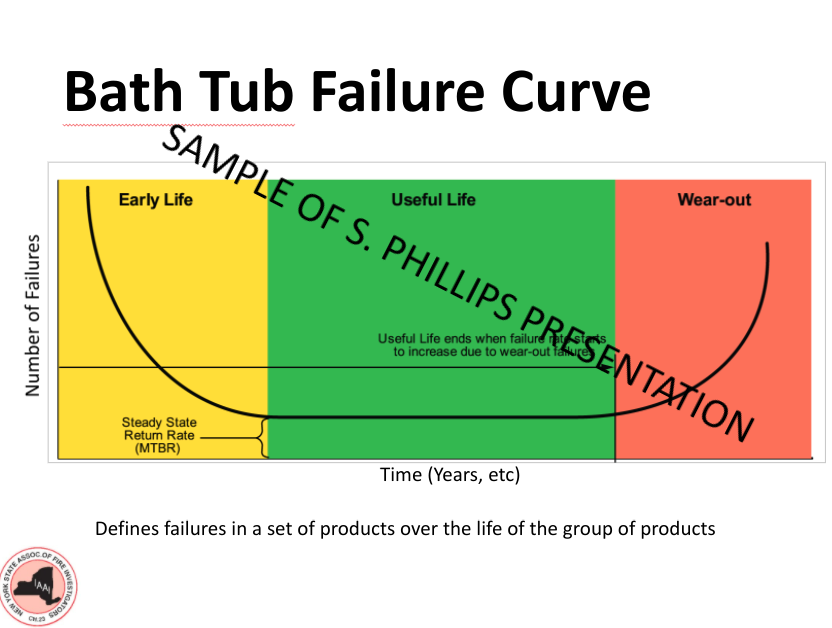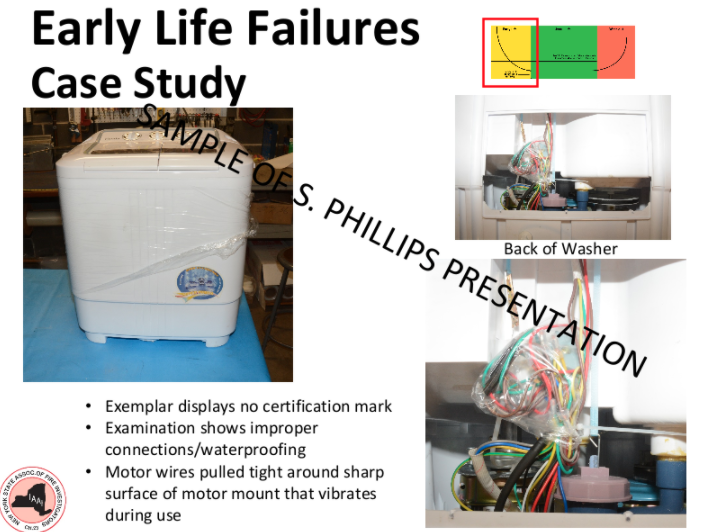On February 25th, 2017, NYS Fire Investigators Chapter 23 held their annual IAAI Training Seminar.
Among the presentors and lecturerers at the seminar was Forensic & Failure Analysis’s Vice President, Mr. Scott Phillips, PE. Mr. Phillips’s lecture “Appliance Failure Basics.” This post summarizes the bulk of Mr. Phillips’s presentation. Please contact FFA if you, your company, or your team would be interested in having Mr. Phillips provide this complete presentation.
A Product’s Life Span & ‘The Bathtub Curve”
A “bathtub” curve is a graph that represents the the relative failure rate of an entire population of products over time.
It is called the “bathtub curve” because it resembles the cross-section of a bathtub: steep sides with a flat bottom.
It is important to clarify and note that this concerns the failure rate of any entire group of specific products, as opposed to a singular individual product.
Stages of Failures
Some individual product units will fail relatively early (called “infant mortality failures), others will last until wear-out, and some will fail during the relatively long period typically “called normal life.”
Infant Mortality Failures
Articles of manufacture that experience failures during infant mortality are highly undesirable and are often caused by defects and blunders: material defects, errors in design or assembly, etc.
Normal Life Failures
Normal life failures are normally considered to be random cases of “stress exceeding strength.” However, many product failures often considered normal life failures are actually infant mortality failures.
Wear-Out (End-of-Life) Failures
Wear-out is a fact of life due to fatigue or depletion of materials (such as lubrication depletion in bearings).
A product’s useful life is limited by its shortest-lived component. A product manufacturer must assure that all specified materials are adequate to function through the intended product life.
Many, including:
- Potential Design Flaws
- Potential Manufacturing Flaws
- How the product is shipped – including the risk of damage during shipping
- Potential Installation Issues
- Who is using the product (consumer or commercial)
Case Study
A case study exhibited in Mr. Phillip’s lecture concerned a washer that had experienced failure. An examination uncovered improper connections and water-proofing within the unit. The motor wires were pulled tightly around the sharp surface of the motor mount that vibrates when in use. Additionally, the washer’s exemplar displayed no certification mark. These are all indicative of an “Early Life” failure for the washer.
Conclusion
The understanding of the interplay of product life cycles, product design, and usage helps inform the investigating engineer on how and why a device may have failed.
For an engineering firm that considers all aspects of your specific loss contact FFA.
Notice:
The information provided by Forensic and Failure Analysis (FFA) to clients, colleagues, potential clients, and others for educational and informational purposes only. No explicit or implied content accuracy or applicability guaranteed to the reader for a specific case or circumstance. This information is not intended to provide expert opinions or create a legal relationship. You should not take, or refrain from taking actions based on its content



